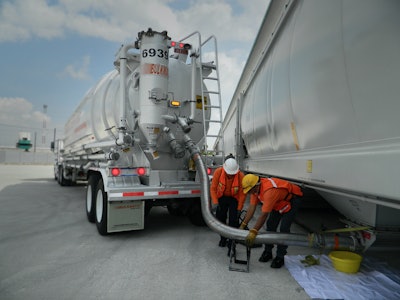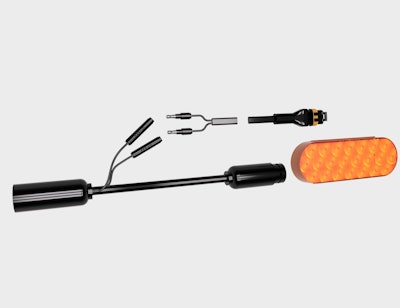Following a 30-month study that ended last year, Groendyke Transportation learned that the addition of a relatively simple, pulsating amber brake light reduced rear-end collisions by roughly 34%.
The Oklahoma-based hazmat hauler had received an exemption from the Federal Motor Carrier Safety Administration (FMCSA) to mount the light on the back of 632 of its tanker trucks, and in two-and-half-years they saw a 33.7% drop in rear-end crashes along with the elimination of all railroad crossing rear-end accidents.
A reduction like that in accidents caught the attention of safety experts at the FMCSA which is now expected to grant an exemption for amber pulsating brake lamps on all tank truck carriers.
“Rear end collisions with a truck is indeed something that can be reduced,” said Paul Menig, executive director at the Transportation Safety Equipment Institute, which recently filed comments with FMCSA in support of an exemption request made by National Tank Truck Carriers (NTTC).
 While some favored a red pulsating brake light on tanker trucks, the Transportation Safety Equipment Institute supported amber
While some favored a red pulsating brake light on tanker trucks, the Transportation Safety Equipment Institute supported amber“I would expect FMCSA sometime this year to grant the exemption for the rest of the tank trailers,” Menig continued.
A blanket exemption for all tanker trucks is welcomed news for NTTC.
“If you’re going to cut accidents by 30 to 40%, that’s great. That’s what it’s all about,” said NTTC President Daniel Furth. “The distracted driving issue is out of control and extremely dangerous. Where it’s evidenced most is where these people are flying right into the back of cars and, in this case, a tank truck right in front of them.”
By approving of amber brake light exemptions for all tanker trucks, Menig said FMCSA will be able to study the light’s effectiveness with other carriers. But they’re not the only ones watching.
“From what I’m seeing, NHTSA is already keyed up to do something,” Menig said.
Approval from the National Highway Traffic Safety Administration (NHTSA) will pave the way for manufacturers to offer the amber pulsating light as factory option, which Menig said will reduce costs for fleets.
“Everyone’s going to reduce cost if we could make this something that could be ordered with a trailer at initial production,” he said. “That takes out a lot of the cost associated with it.”
However, Menig advised that it will probably take multiple years before it would be allowed under NHTSA.
“You have to get NHTSA involved and I think they’re going to need some additional data in order to meet the government requirements for efficacy that they’ll have to meet,” Menig said. “We agree with the exemption and we want people to develop standards and monitor what’s going on to be able to take it to the next step where it is factory installed.”
In the meantime, fleets will be able to turn to the aftermarket for light kits. Optronics reported that it will offer a kit, which it expects will cost fleets around $75.
“We all know that when you’re on the road visibility equals safety,” said Marcus Hester, vice president of sales and marketing at Optronics International. “A pulsating brake lamp will definitely do that.”
 A pulsating amber brake light from Optronics is expected to sell for around $75
A pulsating amber brake light from Optronics is expected to sell for around $75Installation should be relatively easy for most fleets.
“There are some harnesses now that have a drop-out for that option to be added easily to their system,” said Optronics Engineering Manager Brett Miller. “It’s just simply a brake light and ground connection point. For some manufacturers, we already provide the ability for them to have that and this is just simply a change in light and function.
“It’s a rather simple retrofit for some. For others, obviously it involves adding a bracket and a light, or some manner of holding a light and then wiring will have to be put into the system, Miller continued, “whether it be spliced in or bullet connector points or perhaps a T-bone harness that go into a system that we’ve already built. There’s lots of ways that it can be done and it’s really not horribly difficult and even for those older trailers that already have a high mount steady burning red stop light, they could be retrofitted out easily to this amber pulsating light without changing anything other than the light.”
The brake light’s amber color has caused concern for some who think red is a better option.
“The exemption request from NTTC suggested amber or red and we took the position, as did others, that it should only be amber,” Menig said. “There’s enough precedent in other applications and in state regulations for using amber versus using the red.”
Amber pulsating brake lamps may eventually be permitted on other trucks.
“An additional FMCSA exemption beyond this narrow one for tank trailers would be possible in a year-and-a-half maybe,” Menig said.
However, such exemptions have to consider various trailer designs, which can get complicated when it comes to creating standards for adoption.
“When you start talking a dry van trailer you get into some other issues regarding where you place the lamp, the size of the lamp and some other things,” Menig said.
Light installations for intermodal and stake trucks will also prove challenging, Menig said.
“If we limit it to just hazardous cargo, I think we can go from tankers to other hazardous cargo that is in unique trailers—bulk cargo trailers and some other things,” Menig said. “If you try to say, ‘Well, we’re going to try doing it on all hazardous vehicles’, again, it’s very common to carry hazardous gas cylinders on a stake truck. That’s not an easy installation then. There’s some work that needs to be done to figure those things out.”












